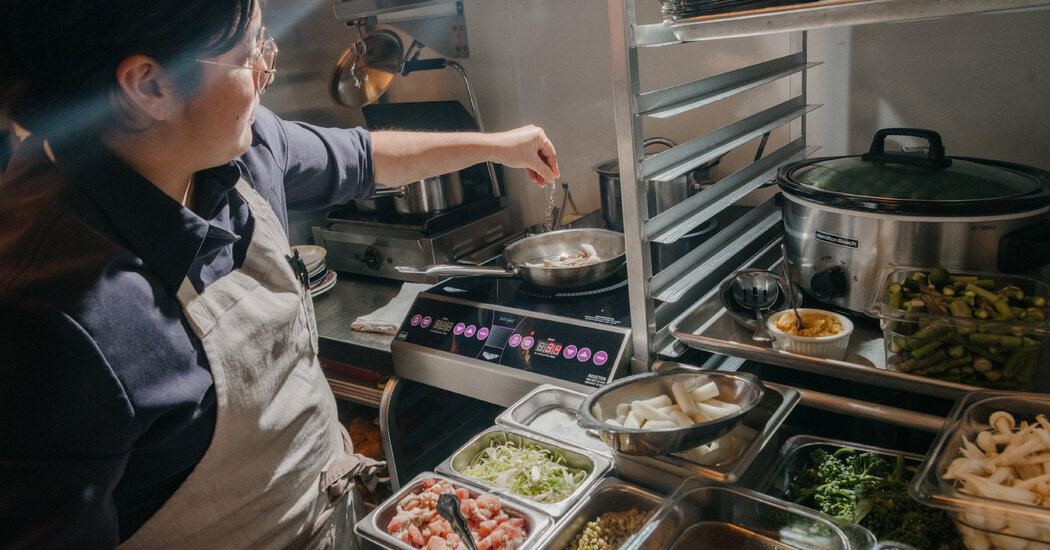What happens when a restaurant has no refrigerator? No gas? Almost no kitchen space? In some cases, brilliance.
As rents and other expenses rise, many restaurants across the country are saving on space and operating without a full-service kitchen. Their chefs are grilling on panini presses, smoking eggplant with no smoker, crisping chicken wings with no fryer. They are constantly forced to focus and adapt — and their menus are all the more exciting for it.
Plenty of chefs can whip up sumptuous steaks aged in temperature-controlled refrigerators in state-of-the-art kitchens. Far rarer, and more impressive, are the ones who can conjure complexity and depth without so much as a gas stove. Here’s how five restaurants make the most with the least.
Overworking the Panini Press
Friends and Family, Oakland, Calif.
It’s hard to believe that inventive dishes like yaki onigiri with tuna miso and sardine bánh mì toast come out of the kitchen setup at the Bay Area wine bar Friends and Family: two induction burners, a slow cooker, a rice cooker and a panini press.
After starting as a bar in 2020 and closing during the Covid lockdowns, Friends and Family reopened in 2021 with a menu of grilled cheese sandwiches and occasionally, pulled pork cooked in a slow cooker, to satisfy a city rule that required bars to serve food.
The current chef, Gaby Maeda, saw the basic layout as a fun challenge. She realized, for example, how many applications there are for a panini press: griddling onigiri, charring cabbage, searing onions. Because there’s a lid to press down, she said, nothing requires flipping — unlike a plancha or a flattop.
Without a fryer, Ms. Maeda bastes chicken wings with brown butter to “mimic the unctuousness of fried items,” she said. There is no hood ventilation system, so she designed main courses that don’t produce much grease: rice cakes with mushrooms, broccoli and asparagus and brothy beans with garlic chive pistou. The slow cooker has been repurposed to marinate olives in fennel and citrus for an appetizer.
“I feel like the space forces you to refine and edit a dish to its most pure form,” said Blake Cole, the owner. “All the ruffles go away, and you just get to the heart of the dish.”
Making Mexican Without a Grill
Alma Fonda Fina, Denver
What is Mexican food without char and smoke? This was the quandary for Johnny Curiel when he opened Alma Fonda Fina in a small space where gas ranges weren’t permitted because the building is a protected landmark.
“It was like, ‘OK, Johnny, you are trying to recreate your mom’s frijoles puercos and birria borega,’” said Mr. Curiel (top, second from right), who started the restaurant in 2023. “How are you going to do this out of a 72-inch station with no fire?”
With only three induction burners and a vector oven, he decided to create a menu of mostly crudos and braises. The 300-square-foot kitchen, directly in front of the bar, has three stations, each about the size of a cutting board: one for cold appetizers, one for crudo and one for hot items. At a griddle in the back, masa is ground, nixtamalized and transformed into sourdough tortillas. Because there’s so little space between the kitchen and guests, the cooks double as servers.
To make birria without a stovetop, lamb shanks are cured in salt and pepper for 24 hours, seared on induction burners, braised overnight in the oven with guajillo chiles, tomato, vinegar and spices, kept warm in a sous-vide machine, then crisped in the oven before service.
Mr. Curiel has a similar process for barbacoa, and finds this workaround yields more of a consistently “melt in your mouth” texture than the traditional methods. “I have always done it the way it is in Mexico, the way my mom showed me,” he said. “Innovating to make sure that this worked for the restaurant, we came out with a 10-times-superior product.”
Getting Guests in on the Action
Kultura, Charleston, S.C.
The chef Nikko Cagalanan dreads the moment when he has to tell a Filipino family that there is no lumpia. The fried spring roll is one of the Philippines’ signature dishes, and Kultura is a Filipino restaurant.
“They are outraged,” said Mr. Cagalanan. But the Kultura kitchen — all of five feet long — has no hood, so he can’t fry or sauté. When the restaurant opened in 2023, the kitchen had just one plug to power an induction burner, a small refrigerator and the patio lights. Guests sitting at the bar are “one hand away” from the cooks’ stations, he said.
But there are benefits to that intimacy. “I just love the idea of people seeing what we are making, so that there is nothing hidden,” he said. “I will take the drinks order, pour the water, chitchat with them, take the order. That is the best part. I love doing that.”
These constraints also force the team to think outside the box, said Mr. Cagalanan. Instead of searing scallops for his scallop adobo, he makes a sauce of coconut milk, onion, ginger, garlic and scallions and poaches the scallops in it, before brushing the dish with garlic honey and torching the top like a crême brulée. He brushes snapper with a scallion-and-ginger relish and roasts it in the small oven, which prevents him from having to make and reheat a pan sauce every time someone orders the fish.
“I used to be a guy with so many touches when plating,” he said. “Flowers, herbs, crunchiness, texture. Now, it is just: Make a good protein or a good braising liquid, a good starch and sauce. And then you don’t need flowers.”
Letting a Small Space Stretch You
Sunn’s, New York City
Sunny Lee was boiling potatoes for potato salad on an induction burner temporarily set one recent afternoon in the middle of the dining room at Sunn’s, her Korean wine bar in Chinatown. She had just returned from Tolo, the Chinese restaurant next door, where she borrowed a wok to char broccoli for namul, a side dish seasoned with sesame oil, garlic and dried mushroom. Her kitchen accessories — scissors, microplanes, strainers — were hung on the walls like paintings.
Behind the bar, crammed into a small station barely wide enough for one person, were two rice cookers, a combination oven, an induction burner and an under-the-counter fridge. During service, Ms. Lee and her sous-chef, Agness Kim, maneuver around each other in a tightly choreographed dance. This is nothing unusual for Ms. Lee, who ran pop-ups out of her 600-square-foot Brooklyn apartment for five years before opening here last December.
“To be creative,” she said, “you have to stretch yourself out of whatever you are in. I have always been in this space where I want to be a little uncomfortable.”
Lacking a way to sear on high heat, Ms. Lee folds shallot powder into a tart dressing for wax beans to mimic the flavor of charred vegetables. The smokiness of her eggplant namul comes from smoked Turkish chile flakes. She didn’t have fridge space for loads of fresh produce, so she dreamed up one of New York’s best salads. It consists of several components that can sit at room temperature, like pickled vegetables and torn dates, all tumbled à la minute onto a swoosh of tahini-tofu dressing.
Ms. Lee has worked in the capacious kitchens of fine-dining restaurants, but she prefers spaces like hers because they “force me to problem solve while wearing many hats, which is a big component of my own creative process.”
She also likes a cozier dining room. “I wanted a restaurant to feel like people are coming into my home,” she said. “I don’t want to ever go into a ‘Yes, Chef’ environment again.”
Fermenting for the Fridge-less
Cellar Door Provisions, Chicago
When Cellar Door Provisions, an acclaimed Chicago restaurant, reopened after the pandemic in 2022, the owner, Ethan Pikas, couldn’t afford to operate it in the same way. So he expanded the wine list, shrank the kitchen by a third and added 18 seats, all in hopes of boosting revenue. Now, in a small corner, he and the chef de cuisine, Alex Cochran, make two-thirds of the menu in a combination oven, which can bake buns, simmer stock and roast a pig’s head. The kitchen is supplemented by a gas range and a few pieces of equipment, like a proofer and a meat grinder. One drawback is minimal refrigeration.
To adapt, Mr. Pikas (top, right) relies on one of the oldest means of preservation: fermentation. White asparagus is tossed into brine. Cabbage is turned into kimchi or sauerkraut. Fig leaves are submerged in vinegar. The proofer, which was once used for making pastries, is now a fermentation chamber. All of these condiments help add depth to a dish when there’s limited space to build complex flavors in a pan, said Mr. Pikas. The fig-leaf vinegar, for example, winds up in a beurre blanc to dress up a filet of sole. The white asparagus punches up a beef tartare.
The cramped space forces communication between the employees, who all take turns washing dishes. “There is no room for people shutting down,” Mr. Pikas said. “In our best moments, it results in a really good and positive kitchen environment.”
He sometimes dreams about having a bigger restaurant with a walk-in refrigerator. But he worries that more resources would mean less innovation.
“It is a really good quality to instill in a cook to work with what little you have afforded to you,” he said.









